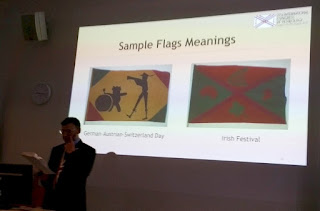This year, there was the smallest of smallest Vexi-Bits at an ICV. Usually Vexi-Bits take place in an informal matter. Typically a NAVA person is chosen to organize an after hours meeting to discuss random flag topics, where each speaker gets 1-3 minutes to talk about his or her flag related item. At ICV 27 Lodon, Vexi-Bits were set up at a last minutes notice. But the schedule was already heavily booked with activities, consequently
Vexi-Bits ICV 27 London ended up as a solo act. But it was a powerful Vexi-Bit nonetheless, that may effect all other Vexi-Bits to come!
 |
| Ted Kaye, Holding a Vexi-Bit Flag: London ICV 27 |
Interestingly the solo Vexi-Bit saw the first design proposal for a Vexi-Bit flag.
The Vexi-Bit flag like the UK Union Flag is a combined flag, derived from three flags. With the UK
Union Jack, the
three components that make up the British Ensign are the banners of Scotland, England, and Irish St. Patrick's Cross flag. Likewise the three elements of the Vexi-Bit Flag are the NAVA flag and two of the International Maritime flags: the letter V and letter B. Obviously V stands for Vexi, while the B stands for Bits. The Vexi-Bit flag has a swallow tail design, as it is for the wholly red Letter B-Bravo flag. Thus it is fitting that the first Vexi-Bit flag should manifest itself in the UK under a triplet flag, being a triplet flag itself.
Thus the Vexi-Bit flag declares subconsciously, "
Victory for NAVA, Bravo!"
https://nava.org/
 Notice that Hardy added a yellow ring to the national flag of Bangladesh to provide contrast. China's flag was given a major zoom in, with the flag of South Korea underwent a major change.
Notice that Hardy added a yellow ring to the national flag of Bangladesh to provide contrast. China's flag was given a major zoom in, with the flag of South Korea underwent a major change. 








